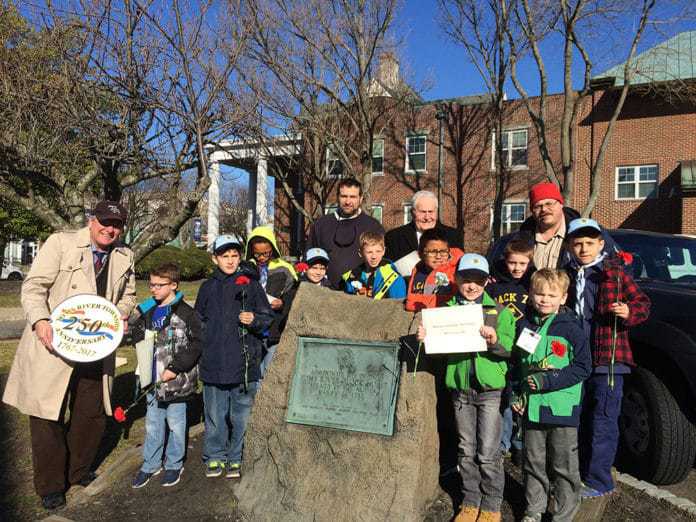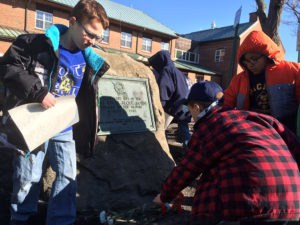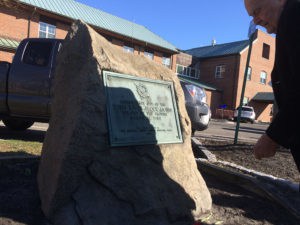
TOMS RIVER – A Boy Scout den learned about Toms River’s surprising role in the Revolutionary War and laid flowers at a monument in memory of nine soldiers who were killed in a battle that threatened peace efforts between the revolutionaries and British.
Ten Beachwood boy scouts with Jersey Shore Council Den 6, with Pack 70 attended a brief talk and viewing of a movie on March 22, a few days before the anniversary of the British attack on March 24, 1782. The scout event was part of a year-long celebration of the 250th anniversary of Toms River.

Den leader Tim Williams, and co-leader Louis Ricart, said that history is one of the key goals of this troop this year.
They watched a short film, “Toms River Block House Fight.” The 22-minute movie was filmed in 1976, and showed what life was like in the village of Toms River a few hundred years ago. The recreation of the events were written and directed by Pauline S. Miller, a long-time county historian who passed away in 2011. Through a bit of movie magic, the movie was not filmed in Toms River but in Double Trouble State Park in Berkeley Township. It was re-enacted using local figures in the lead roles.
Mayor Thomas Kelaher and Township Clerk J. Mark Mutter brought the scouts up to speed on some of the background leading up to the events in the film, referring to them as ancient history. Although for these kids, 1976 was also ancient history.

The events centered around Capt. Joshua Huddy, who had command of the block house in Toms River, near where the municipal complex is now. The block house was used to train and house the militia which was there to protect the salt works and the village. There were 25 soldiers serving the fort at any time.
The Revolutionary War had ended. But it almost didn’t.
An army made up of British soldiers and loyalists marched down Squan Road to the village, eager to exact revenge on Huddy. Garrett Irons, a lookout, said he saw the British ships on route. The Toms River militia did not heed his warning that the British were coming, though.
The British overwhelmed the Block House, killing 9 soldiers and capturing Huddy. For good measure, they also burned the block house and all but two houses in the village. They took Huddy and hung him. Huddy’s last words were, reportedly, “I shall die innocent and for good cause.” A sign was put on his chest that read “Up goes Huddy for Philip White,” a loyalist farmer who died in Huddy’s custody.

The patriots were furious when they heard about this. The war was over, and the British had attacked an American fort and executed its leader. Some wanted the war to start again. Some wanted the British to hand over one of their own soldiers, of equal rank, to be executed. Ultimately, there would be no more bloodshed from these actions. Instead, the American leaders would be able to wring some concessions from the British over the incident, Mutter said.
Historical figures such as George Washington, John Adams, and Ben Franklin were watching what was happening in the little village of Toms River.
After the film, Mutter asked the scouts “Who won the battle of Toms River?”
“The British won the battle but we won the fight for freedom,” he said. “The story of Toms River is about that.”
Then, each scout was given a rose and the name of one of the Toms River soldiers. They walked out to a monument on Robbins Street. It’s a stone with a plaque that designates that spot as the “Approximate site of the Toms River Block House, burned by the British, March 24, 1782.”







